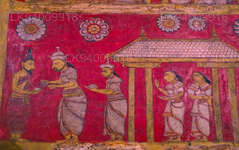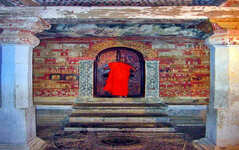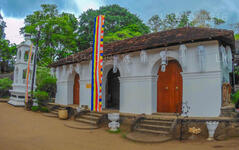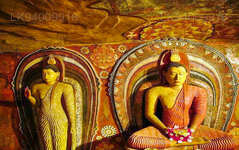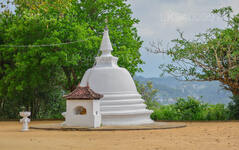
Cidade de Kandy
Kandy, uma cidade pitoresca no centro do Sri Lanka, é famosa por seu rico patrimônio cultural, festivais vibrantes e beleza cênica. Aninhada em meio a colinas verdejantes, abriga o Templo da Relíquia do Dente, Patrimônio Mundial da UNESCO, e oferece uma mistura cativante de história e esplendor natural.
Degaldoruwa Raja Maha Vihara
Amongst the rocky slopes and green valleys of rural Kandy lies a hidden treasure; the Degaldoruwa Raja Maha Vihara. This temple awes those who view it with its incredible Kandyan era frescoes. Construction of the temple began in the late 1770s under the reign of King Kirti Sri Rajasinha and was completed under the reign of his brother Rajadhi Rajasinha years later.
Legend
According to folklore a farmer was exploring the area and found a crevice between two rocks. On venturing into space he found a cave with a pile of golden sickles. The farmer was delighted with his discovery but feared retribution from some strange power. So he simply took only one sickle every morning and, after using it in his fields, returned it in the evening. His fields yielded an extremely healthy harvest and the farmer attributed it to the golden sickle. But then he became greedy. After all, he had been taking the sickles every day and there had been no ill effects, and there was a whole pile of them. So on the very last day of the harvest, he took two sickles instead of one and did not return one of them.
But unknown to the farmer, there had indeed been a guardian for the treasure. The guardian noticed the farmer taking the sickles, but kept quiet as he always returned them. On the day that the farmer took one sickle for himself, the guardian saw it at once and confronted him in his home. The terrified farmer immediately rushed to the crevice and returned the golden sickle that he had stolen. The guardian, who had been disappointed, then sealed the crevice by fusing the two rocks together. However, the villagers got to know this story and informed the king, Kirti Sri Rajasinha; who then ordered that the cave be found and a temple erected in it.
The Structure
- The temple is hollowed out of a 40 foot rock outcrop extending a natural cave. It consists of an elegant rock shelter with two roofed antechambers in front; a drummers’ hall and an image house; and the main shrine room cut into the rock itself. The two antechambers are constructed outside the rock outcrop and have wooden roofs.
- The architecture is unusual for the period as the drummers’ hall is not usually attached to the main temple.
- The image house is located through a set of old wooden doors, situated under a carved wooden Dragon Arch. It preserves a moonstone and a sequence of elaborate and colorful paintings showing scenes from four Jātaka tales, which tell the stories of the previous lives of Buddha.
- The door of the shrine room is banded with metal and once had jewels embedded within it. The inner walls of the shrine are completely covered in paintings; including the door.
- In addition to this main structure, there is a bo tree and a stupa on a plateau on the summit of the rocky outcrop above the temple. They can be reached by stairs carved into the temple.
The Frescoes
The paintings of Degaldoruwa, which are supposed to be some of the best of the Kandyan era, are believed to be the work of four ‘Sittara’ artists. The finest of these paintings grace the ceiling of the temple; ‘Mara Yudde’, an artistic depiction of Buddha’s internal spiritual battle against Māra, the demon of death, rebirth, and desire.
The murals are unique in that all the elements; the people, the trees and the animals; are a uniform size and only the front views of ]people are shown. The trees have a stylized form, with their branches and leave spreading out to either side. The individual elements, such as the adornments on the elephants and the uniforms of the attendants, are portrayed in great detail. All of the colors used by the artists in the murals were created from the barks
Sobre o distrito de Kandy
O distrito de Kandy está situado na província central do Sri Lanka. Um dos sete Patrimônios Mundiais do Sri Lanka, Kandy já foi o lar dos Reis Kandy de outrora no século XVI e uma fonte de toda a música, artes, artesanato e cultura do país. A cerca de 129 km de Colombo, Kandy está situada em um terreno montanhoso e todos os olhos são atraídos para o centro da cidade, onde o Lago Kandy forma uma característica encantadora. Kandy mantém grande significado religioso para o Sri Lanka, porque é nesta cidade encantadora que o Dalada Maligawa ou "Templo do Dente" está localizado, dentro do qual a relíquia sagrada do dente do Senhor Buda está bem guardada. O Jardim Botânico Real, Peradeniya, está situado a cerca de 5 km a oeste do centro da cidade em Peradeniya e é visitado por 1,2 milhão de pessoas por ano. É o maior jardim botânico da ilha. O Udawatta Kele (Floresta Udawatta) é um santuário protegido situado no coração da cidade, ao norte do Templo do Dente. Kandy é uma cidade de maioria cingalesa; há comunidades consideráveis pertencentes a outros grupos étnicos, como mouros e tâmeis. Kandy fica atrás apenas de Colombo no centro da economia do Sri Lanka. Muitas grandes cooperativas têm grandes filiais em Kandy e muitas indústrias, incluindo têxteis, móveis, tecnologia da informação e joias, são encontradas aqui. Muitos centros de pesquisa agrícola estão localizados na cidade. E uma fonte para toda a música, artes, artesanato e cultura do país. A cerca de 129 km de Colombo, Kandy está abrigada em um terreno montanhoso e todos os olhares são atraídos para o centro da cidade, onde o Lago Kandy forma uma característica encantadora. Kandy mantém grande significado religioso para o Sri Lanka, porque é nesta cidade encantadora que o Dalada Maligawa ou Templo do Dente está localizado, dentro do qual a relíquia sagrada do dente do Senhor Buda está bem guardada.
Sobre a Província Central
A Província Central do Sri Lanka é constituída principalmente por terrenos montanhosos. A província tem uma área de 5.674 km² e uma população de 2.421.148 habitantes. Algumas das principais cidades incluem Kandy, Gampola (24.730 habitantes), Nuwara Eliya e Bandarawela. A população é uma mistura de cingaleses, tâmeis e mouros. Tanto a capital montanhosa, Kandy, quanto a cidade de Nuwara Eliya estão localizadas na Província Central, assim como Sri Pada. A província produz grande parte do famoso chá do Ceilão, plantado pelos britânicos na década de 1860, após uma doença devastadora ter dizimado todas as plantações de café da província. A Província Central atrai muitos turistas, com cidades montanhosas como Kandy, Gampola, Hatton e Nuwara Eliya. O dente-de-templo ou Dalada maligawa é o principal local sagrado da província de Centrel. O clima é fresco e muitas áreas a cerca de 1.500 metros de altitude costumam ter noites frias. As encostas ocidentais são muito úmidas, com alguns locais recebendo quase 7.000 mm de chuva por ano. As encostas orientais fazem parte da zona meio seca, recebendo chuva apenas das monções do nordeste. As temperaturas variam de 24°C em Kandy a apenas 16°C em Nuwara Eliya, localizada a 1.889 m acima do nível do mar. As montanhas mais altas do Sri Lanka estão localizadas na Província Central. O terreno é predominantemente montanhoso, com vales profundos que o cortam. As duas principais regiões montanhosas são o Maciço Central e a Cordilheira Knuckles, a leste de Kandy.


